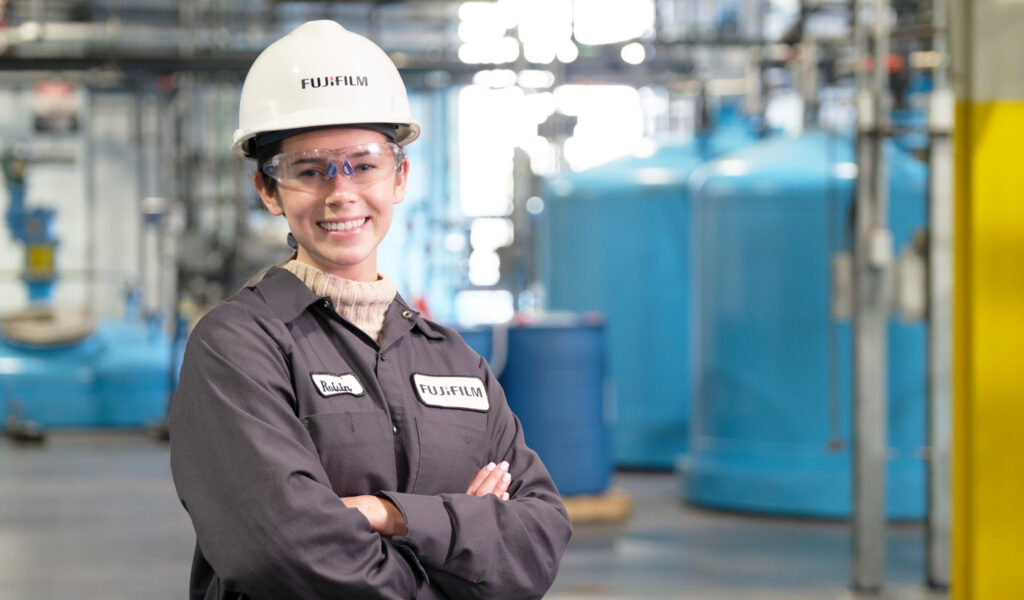One of the key reasons Fujifilm excels in high-quality water-based inkjet ink manufacturing is solid collaboration. And this is support by precision, innovation, consistency, and a seamless transfer of product from lab to plant manufacturing scale.
“We have an experienced knowledge base gained over decades but also a culture of innovation and challenging what we do to make that next step more efficient and maintain our quality”, Roisin Breen, Process Engineer

As a process engineer, I work closely with our machine operators. My background in chemical engineering helps me to make informed decisions on a technical basis, but I’ve learned a lot working hands-on in the field. Operators have the best knowledge base and are always helpful, while I’m willing to listen and learn, which builds trust.
The manufacturing floor runs 24 hours, five days a week. I spend much of my day there, equipment troubleshooting, helping operators resolve quality issues, ensuring we’re running our processes efficiently and maintaining the highest product quality.
I collaborate with all the different departments, working closely with the Technical team, as they support daily operations, our Maintenance teams who help us stay running, the Quality Control (QC) team in the laboratory, Supply Chain, and Quality Assurance (QA).
Innovating to achieve inkjet consistency and repeatability
Between all our USA site team members, we have decades of experience, a robust knowledge base and there’s also a culture of innovation. We’re constantly pushing to see what we can do next to manufacture our product more effectively, whether that’s cycle time or quality improvements. Everyone on site is eager to help each other, and we have many collaborative meetings where we get different departments’ perspectives.
To ensure consistency and repeatability, we do a lot of process testing, monitoring what we’re doing from batch to batch. For example, we look at our water quality very closely because we make aqueous inks, which are water-based. I’ll monitor the water quality daily and act as needed to maintain it.
We treat incoming city water that goes directly into a reverse osmosis unit to purify it before going into a storage tank where we keep treated water for use in the plant. It never sits stagnant – we pull a lot of samples and test them to ensure we maintain that high quality. The main component we look for is bacteria growth, as this could plug printheads.
Ensuring inkjet ink quality requirements
We ensure our processes are within tight control limits, with specifications for every quality parameter we test, whether surface tension or conductivity, on our final products.
We have lower and upper specifications that our products always need to be within to ensure what we’re sending customers meets their quality requirements, their forecasted demand, and their expectations for the product. We also do in-process tests – taking samples and ensuring they are the quality we expect them to be at that step. We monitor those results over batches to ensure we don’t have much variability.
Then, we’ll have collaborative project meetings where all the departments align on the customer’s needs and ensure they deliver in their specific areas. Finally, we work on what we’ve agreed and return a few times to check with each other. And we are working with the customer through to scale up and making the product.
Challenges in water-based inkjet ink manufacture
The main quality issues you could face are in the process or raw materials. Another challenge is taking a product from a lab where you might be using beakers and scaling up to plant scale and large tanks. Part of my job is ensuring we can scale up. Onboarding new customers involves visiting their site and frequent meetings with the customer team to ensure we correctly transfer their product from the lab scale to the plant manufacturing scale.
For example, we had a product scale-up where the raw materials we were charging into the tank had to be an exact amount. Our accuracy scale is usually in the ± 2% range, but this had a much tighter tolerance. Getting that type of precision at a smaller or lab scale is more manageable. So, we worked with our team in Japan to come up with a practical way for operators to charge raw materials with tight accuracy.
Collaboration is key. This means years of experience and backgrounds in different areas giving us new perspectives and ideas we can bounce off each other. Then, when we come to alignment, we have the best path forward.